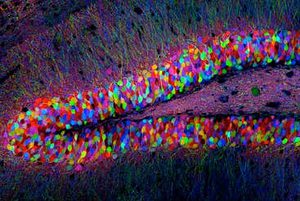
When the brain deems an experience meaningful enough, it will transfer that information from short-term storage, where typically information like where you put your car keys or the phone number of a person you just met gets stored temporarily, to your long-term memory, offering the possibility to be accessed at a later time. Neurologists claim this recording is made in the brain by strengthening the connections between groups of neurons that participate in encoding the experience, a pattern of connections which is referred to as an engram. These engrams will typically stay dormant unless they’re stimulated by a cue, which will evoke the event back into memory.
This explains why a song playing in the background might instantly transport you back to a special event tied to the track or the sweet scent of a freshly baked pie might transport you back in time to when you were a child. There are a myriad of such “anchors” dispersed though out our neural network, however the existence of engrams beyond their hypothetical nature has been debated for a while, as their exact mechanism and location has been a focus of persistent research for many decades. Now, a recent research conducted by scientists at MIT which made use of optogenetics demonstrates that memories are indeed stored in specific brain cells.
“We demonstrate that behavior based on high-level cognition, such as the expression of a specific memory, can be generated in a mammal by highly specific physical activation of a specific small subpopulation of brain cells, in this case by light,” says Susumu Tonegawa, the Picower Professor of Biology and Neuroscience at MIT and lead author of the study reported online today in the journal Nature. “This is the rigorously designed 21st-century test of Canadian neurosurgeon Wilder Penfield’s early-1900s accidental observation suggesting that mind is based on matter.”
A breakthrough in neuroscience
Dr. Penfield is one of the most influential figures in neurosurgery, a pioneer in the field whose legacy includes, among others, the first maps of the sensory and motor cortices of the brain showing their connections to the various limbs and organs of the body, still used today, unaltered. He was a man inherently concerned with the various subterfuges of the human mind, and dedicated his life to understanding how the brain works and whether there is any scientific basis that might acknowledge the existence of the human soul. One of his most groundbreaking works is the elaboration of the Montreal Procedure, a controversial surgery in which he treated epilepsy patients by severing nerve cells in the brain where the seizures originated. The operation would take place under local-anesthesia, as the patient’s collaboration was deemed indispensable. Penfield would destroy only the affected nerve cells by the disease, as he stimulated the brain with tiny jolts of electricity and observed the patient’s response. While probing nerve cells in the hippocampus, the region of the brain responsible for memory formation and storage, some patients would report vivid and complex recollections of past events.
Many discussions followed around these sort of events, but until now, it wasn’t scientifically proven that the simple reactivation of nerve cells in the hippocampus could cause memory recall.
To test their hypothesis, the MIT researchers identified the particular brain cells in the hippocampus that were active only when a mouse was learning about a new environment. They then proceeded in identifying which genes were activated in those cells, and added the gene for channelrhodopsin-2 (ChR2), a light-activated protein used in optogenetic indispensable for the present research, to a genetically engineered mouse.
“We thought we could use this new technology to directly test the hypothesis about memory encoding and storage in a mimicry experiment,” says co-author Xu Liu, a postdoc in Tonegawa’s lab.
“We wanted to artificially activate a memory without the usual required sensory experience, which provides experimental evidence that even ephemeral phenomena, such as personal memories, reside in the physical machinery of the brain,” adds co-author Steve Ramirez, a graduate student in Tonegawa’s lab.
Inception: fear induced on command
The scientists next labelled a population of hippocampal dentate gyrus neurons, using tiny optical fibers to deliver pulses of light to the neurons. Finally, the mice were introduced to an environment and were left to accustom themselves for a few minutes of exploration. A mild food shock was induced all of sudden, which caused the mice to fear the particular environment. The brain cells activated during this fear conditioning became tagged with ChR2. Later, the mice were introduced in a totally different environment, with an obviously different maze and of another smell, and were left there to explore. A pulse of light was triggered onto the neurons involved in the first experience, which lead to the fear memory getting switched on; the mice quickly entered a defensive, immobile crouch. This is called fear conditioning.
“Our results show that memories really do reside in very specific brain cells,” Liu says, “and simply by reactivating these cells by physical means, such as light, an entire memory can be recalled.”
Activation of cells labelled in a context not associated with fear did not evoke freezing in mice that were previously fear conditioned in a different context, suggesting that light-induced fear memory recall is context specific.
“This remarkable work exhibits the power of combining the latest technologies to attack one of neurobiology’s central problems,” says Charles Stevens, a professor in the Molecular Neurobiology Laboratory at the Salk Institute who was not involved in this research. “Showing that the reactivation of those nerve cells that were active during learning can reproduce the learned behavior is surely a milestone.”
The method may also have applications in the study of neurodegenerative and neuropsychiatric disorders. “The more we know about the moving pieces that make up our brains,” Ramirez says, “the better equipped we are to figure out what happens when brain pieces break down.”






